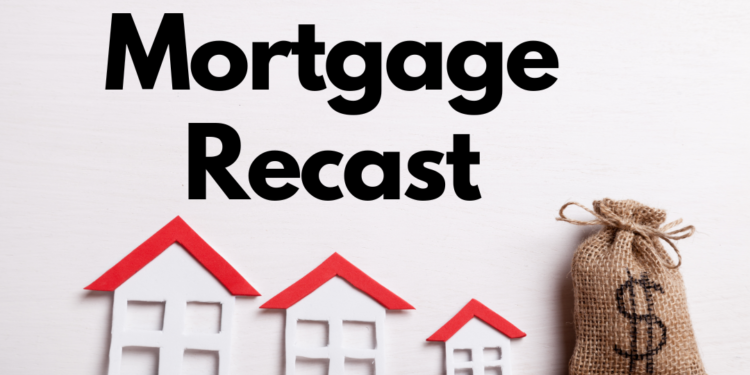What is a mortgage recast?
A mortgage recast, also called a loan recast, is a feature of some types of mortgages where remaining monthly payments are recalculated based on a new amortization schedule. For a mortgage recast, the borrower pays a large sum toward their principal (usually $10,00o or more), and their mortgage is then recalculated based on the new, lower balance outstanding.
Some mortgages have a scheduled recast date, which is the date when the lender will calculate a new amortization schedule based on the mortgage’s remaining principal balance and term.
Mortgage Recast vs. Refinancing
A mortgage recast can be a more comfortable option than refinancing. With a refinance, you replace your current mortgage with a new mortgage loan, which can be costly and depends on your credit standing. A mortgage recast does not involve a credit check and continues with the original mortgage.
On the other hand, refinancing a mortgage means paying off the existing loan and replacing it with a new one. For the borrower, the primary benefit of recasting a mortgage is to reduce monthly payments. Often, a mortgage lender will simply reduce the term of a loan if extra principal payments are made, but maintain the same fixed monthly amount due—simply by increasing the principal amount and reducing the interest portion of the payment.
Recasting can lower the amount of interest the borrower will pay over the life of the loan if a sufficiently large principal payment is made, reducing both the interest and principal remaining on the loan’s new monthly payments.
Benefits of Loan Recasting
- It doesn’t require a closing process, which means that you don’t need to spend the thousands of dollars that tend to go along with closing process. Recasting also does not restart the clock on your mortgage’s duration (happy face).
- If you didn’t have the 20% down payment and therefore had to pay private mortgage insurance (PMI) on your loan, recasting—to the point of having at least 20% paid—may have removed the extra cost of PMI. Plus, you may be able to pre-pay your mortgage even after recasting. Many lenders may let you pay more than your minimum monthly payment, so you can keep whittling down the principal faster if you choose.
The catch
Your current lender may sell your loan to another lender quickly after closing, and different mortgage servicers have slightly different rules about recasting:
Example of a Mortgage Recast
Even if a mortgage does not have a recast option included, you can approach your lender to see if a mortgage recast will benefit you and lower your monthly payments. By paying a lump sum and recasting your mortgage, you can reduce your housing costs. By contrast, if you submit a lump sum without recasting, you lower your balance but your monthly payments will remain the same.
Let’s say you have a $500,000, 7/1 adjustable-rate mortgage with a 6.5% interest rate. Your combined interest and principal payment would be around $3,160 per month in terms of principal and interest.
After some years, you receive a windfall lump sum of $200,000. If you decided to use that lump sum to pay down the mortgage without recasting it, you would continue to pay around $3,160 a month, but the length of the loan would become shorter as you are effectively paying down additional principal.
If, on the other hand, you recast the loan over the remaining 25 years of the mortgage, the monthly payment would go down to around $1900 per month in terms of principal and interest.
Bottom Line
Mortgage recast can you a powerful option to reduce not only your monthly payments but also the total interest paid each month. It could amount to huge saving especially in this high rate environment.
Let’s Connect
Let’s connect if you have questions. This is a changing rate environment and you need a professional by your side to help guide your decision making.












